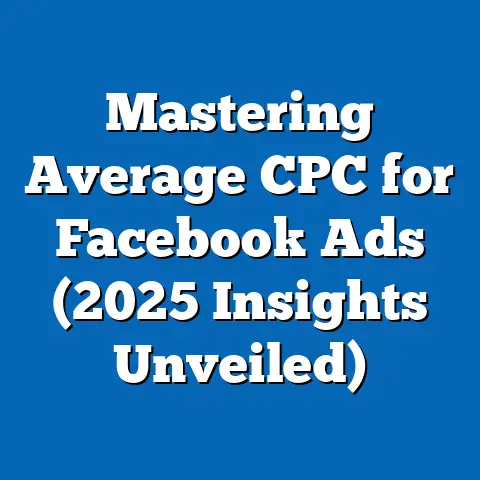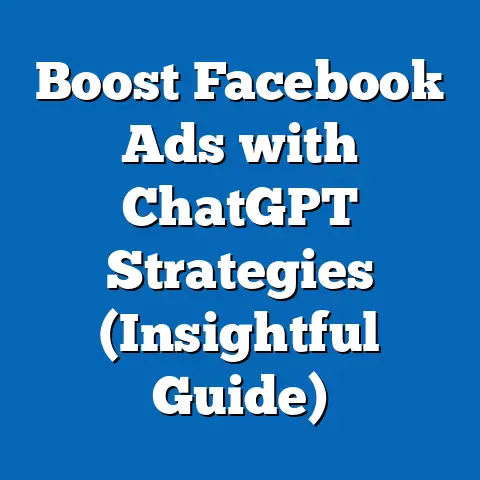Turn fb ad Complaints into Actionable Insights (Expert Strategies)
Turning Facebook Ad Complaints into Actionable Insights (Expert Strategies)
I remember one time, I was running a campaign for a local bakery. We had this beautifully shot ad of a chocolate cake, but we started getting complaints about the price being too high. Initially, we were defensive. But instead of ignoring the feedback, we decided to investigate. What we found was that our perceived value didn’t match the customer’s expectations. We adjusted our messaging to highlight the quality ingredients and the artisanal process, and guess what? The complaints subsided, and sales actually increased! This experience taught me a crucial lesson: complaints are not just noise; they’re data points.
In this guide, I’m going to share my expert strategies for transforming those Facebook ad complaints into actionable insights that will not only improve your campaigns but also strengthen your brand’s relationship with your audience.
Understanding the Nature of Complaints
First, let’s break down the different types of complaints you might encounter. It’s not enough to just see a negative comment; you need to understand why someone is complaining. Here are some common categories:
- Relevance: These complaints usually center around the ad not being relevant to the user’s interests or demographics. They might say things like, “Why am I seeing this? I’m not interested in [product/service]!”
- Targeting Issues: This is related to relevance, but it’s more specific. The user might feel that the ad is targeting the wrong demographic or is based on inaccurate data.
- Ad Content: This category includes complaints about misleading information, offensive content, or simply poor creative execution. I once saw an ad get slammed because it used outdated slang – talk about a quick way to alienate your audience!
- Frequency: This is the classic “I’m seeing this ad too many times!” complaint. Ad fatigue is real, and bombarding users can lead to negative brand perception.
- Misleading Promises: Nothing angers customers more than feeling like they’ve been tricked. Make sure your ads accurately represent what you’re offering.
- Technical Glitches: Sometimes, the issue isn’t the ad itself, but a broken link, a slow-loading landing page, or a faulty checkout process.
Understanding the psychology behind complaints is crucial. People complain when they feel their expectations haven’t been met. This could be due to a perceived lack of value, a feeling of being misled, or simply annoyance. But here’s the thing: people who complain are often more engaged than those who simply ignore your ads. They’re taking the time to voice their concerns, which means they care, at least on some level.
It’s also important to remember that not all complaints are created equal. Some are genuine concerns that need to be addressed, while others might be from trolls or competitors trying to sabotage your efforts. Learning to differentiate between these types of complaints is key to prioritizing your response.
Takeaway: Identify the different types of complaints you’re receiving to better understand the underlying issues. Remember that complaints are a form of engagement and can provide valuable feedback.
Analyzing Complaints: Tools and Techniques
Now that you know what to look for, let’s talk about how to collect and analyze those complaints. You can’t fix what you can’t measure, so having the right tools and techniques is essential.
Here are some tools and methods I recommend:
- Facebook Comments: This is the most obvious source of feedback. Monitor your ad comments regularly and respond promptly to any concerns.
- Direct Messages: Some users prefer to reach out privately. Keep an eye on your Facebook Page’s inbox and respond to messages in a timely manner.
- Facebook Surveys: Use Facebook’s built-in survey tool to gather more structured feedback. This is a great way to get quantitative data on specific issues.
- Third-Party Social Listening Tools: Tools like Hootsuite, Sprout Social, and Brandwatch can help you monitor mentions of your brand and ads across the entire social web.
- Sentiment Analysis: This uses natural language processing (NLP) to determine the emotional tone of a piece of text. It can help you quickly identify negative comments and prioritize your response.
- Keyword Tracking: Track keywords related to your brand, products, and ads to see what people are saying about you online.
- Focus Groups and Interviews: For deeper insights, consider conducting focus groups or one-on-one interviews with your target audience.
Once you’ve collected the complaints, it’s time to categorize them. This involves grouping similar complaints together to identify common themes. For example, you might find that a large number of complaints are related to the price of your product, or that many users are confused about your return policy.
Here’s a simple process for categorizing complaints:
- Create a Spreadsheet: Create a spreadsheet with columns for the complaint text, the type of complaint (relevance, content, frequency, etc.), and any other relevant information (e.g., the ad that generated the complaint, the user’s demographics).
- Read and Tag: Go through each complaint and tag it with the appropriate category.
- Analyze the Data: Once you’ve tagged all the complaints, analyze the data to identify the most common themes.
Don’t forget to monitor your competitors’ ads and customer feedback. This can give you valuable insights into industry trends and potential pitfalls to avoid. What are people complaining about in your industry? What are your competitors doing well (or poorly)?
Takeaway: Use a combination of tools and techniques to collect and categorize complaints. Monitor your competitors to benchmark your performance and identify industry trends.
Turning Complaints into Insights
This is where the magic happens. Now that you have a mountain of complaints, it’s time to turn them into actionable insights that can improve your campaigns. Here’s a step-by-step guide:
Step 1: Identify Patterns
Look for recurring themes in the complaints. What are people complaining about most often? Are there any specific ads or targeting strategies that are generating a disproportionate number of complaints?
Example: Let’s say you’re running a campaign for a new fitness app, and you’re getting a lot of complaints about the app being too expensive. This is a clear pattern that needs to be addressed.
Step 2: Root Cause Analysis
Once you’ve identified the patterns, it’s time to dig deeper and determine the root causes of the complaints. Why are people complaining about the price of your fitness app? Is it because they don’t understand the value proposition? Is it because they’re comparing it to cheaper alternatives? Is it because they simply can’t afford it?
One technique I like to use is the “5 Whys.” This involves repeatedly asking “why” to drill down to the root cause of a problem.
Example:
- Complaint: The fitness app is too expensive.
- Why? Because people don’t see the value.
- Why? Because the ad doesn’t clearly communicate the benefits.
- Why? Because the ad focuses on features rather than benefits.
- Why? Because the marketing team didn’t fully understand the target audience’s needs.
Step 3: Action Planning
Now that you know the root causes of the complaints, it’s time to create a plan to address them. This might involve revising your ad content, adjusting your targeting parameters, or improving your customer service responses.
Example: Based on the root cause analysis above, you might decide to:
- Revise your ad copy to focus on the benefits of the app, rather than just the features.
- Create a video testimonial from a satisfied customer.
- Offer a free trial to let people experience the app before they commit to a subscription.
Real-Life Examples:
- Dove: Dove has built its brand on body positivity. When some of their ads were criticized for promoting unrealistic beauty standards, they took the feedback seriously and launched campaigns that celebrated diverse body types.
- Netflix: Netflix is constantly A/B testing different ad creatives and targeting strategies. When they see a spike in complaints about a particular ad, they quickly pull it and replace it with something else.
Takeaway: Use pattern identification and root cause analysis to uncover the underlying issues behind the complaints. Create a detailed action plan to address those issues.
Implementing Changes Based on Insights
Now that you have your action plan, it’s time to put it into action. This involves making changes to your ad strategy based on the insights you’ve gained from the complaints.
Here are some tips for implementing changes effectively:
- Prioritize Changes: Not all changes are created equal. Focus on the changes that are most likely to have a positive impact.
- Test Changes: Before you roll out a change to your entire audience, test it on a small segment to see how it performs. A/B testing is your friend here.
- Monitor Results: Keep a close eye on your results after you’ve implemented the changes. Are the complaints decreasing? Are your engagement rates improving?
- Communicate Changes: Be transparent with your audience about the changes you’re making. Let them know that you’re listening to their feedback and taking it seriously.
Transparency and responsiveness are key. When you make changes based on customer feedback, let your audience know. This shows that you value their opinions and are committed to providing them with a positive experience.
Example: If you’re revising your ad copy to address complaints about misleading information, you might post an update on your Facebook Page explaining the changes and why you made them.
Takeaway: Prioritize changes based on their potential impact. Test changes before rolling them out to your entire audience. Communicate changes to your audience to show that you’re listening.
Measuring Success After Changes
After you’ve implemented the changes, it’s time to measure their effectiveness. This involves tracking key metrics and KPIs to see if the changes are having the desired effect.
Here are some metrics and KPIs to track:
- Complaint Volume: Are you seeing a decrease in the number of complaints you’re receiving?
- Engagement Rates: Are your engagement rates (likes, comments, shares) improving?
- Conversion Rates: Are your conversion rates (sales, leads, sign-ups) increasing?
- Customer Satisfaction Scores: Are your customer satisfaction scores improving?
- Brand Sentiment: Is the overall sentiment towards your brand becoming more positive?
It’s also important to create a feedback loop where customer insights continually inform your marketing strategies. This involves regularly monitoring customer feedback, analyzing the data, and making changes as needed.
Takeaway: Track key metrics and KPIs to measure the effectiveness of your changes. Create a feedback loop where customer insights continually inform your marketing strategies.
Conclusion
Complaints are inevitable in advertising, but they don’t have to be a source of frustration. By understanding the nature of complaints, analyzing them effectively, and implementing changes based on the insights you gain, you can turn those complaints into opportunities for growth.
Remember, your audience’s voice is the most valuable asset you have. Listen to them, learn from them, and let them guide you to creating more effective and engaging Facebook ad campaigns. Don’t fear the complaints; embrace them as opportunities to improve and connect with your audience on a deeper level. That is how you achieve marketing success in today’s world.






